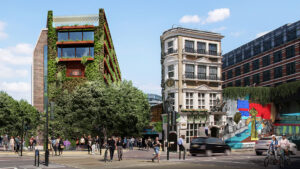Co-living spaces are changing the game in urban real estate investments. Unlike traditional housing, these innovative setups offer flexibility and community living. They attract young professionals and students seeking affordable options in bustling cities. The demand for co-living units is skyrocketing as people crave connection and convenience in space. Investors see this trend as a golden opportunity.
With rising rental prices, co-living unit spaces provide a solution that balances affordability with lifestyle. They cater to a diverse crowd, creating vibrant communities while maximizing space efficiency. This shift in living arrangements signifies a new era in urban investment strategies. Embracing co-living could redefine your portfolio’s potential and yield impressive returns.
Key Takeaways
-
Co-living spaces are becoming a popular choice in urban areas, making them a smart investment for real estate investors looking to meet changing housing preferences.
-
Investors should consider the benefits of co-living, such as higher occupancy rates and community-oriented living, which can lead to stable cash flow.
-
Understanding the innovative building designs that cater to communal living can help investors identify properties with strong potential for growth.
-
Tech-enabled management solutions streamline operations and enhance the living experience, making co-living spaces more attractive to residents.
-
Sustainability is a key factor in co-living developments, appealing to environmentally conscious tenants and increasing long-term value for investors.
-
As urban populations continue to grow, co-living spaces are likely to play a significant role in reshaping real estate trends, offering opportunities for future investments.
Understanding Co-Living Spaces
Definition
Co-living is a modern housing solution. It combines private living spaces with communal areas. Residents share values and experiences. This setup fosters a sense of community. People often seek connection in urban environments. Co-living offers that opportunity.
Flexibility
Flexible lease terms are crucial in co-living setups. Many individuals have different lifestyles and needs. Some may require short-term stays for work or study. Others may want longer commitments for a living space or unit as they settle into a city. These flexible arrangements make co-living appealing to diverse groups.
Residents can choose from various living arrangements. They might opt for a single room, shared apartments, or larger units. This variety caters to students, young professionals, families, and their living space. The flexibility allows people to adapt their living spaces as their lives change.
Community Engagement
Community managers play an essential role in co-living spaces. They enhance resident engagement through organized activities. Regular events help build relationships among residents. These activities can include game nights in the living space, cooking classes, or group outings.
Engagement fosters a sense of belonging. Residents feel more connected to one another and their environment. This connection often leads to improved satisfaction with their living situation. A strong community can also support personal growth, networking opportunities, and a living space.
Communal Workspaces
Many co-living spaces include communal workspaces. These areas provide residents with a place to focus on their projects or studies. They often feature desks, high-speed internet, meeting rooms, and a living space.
Having access to these workspaces encourages collaboration. Residents can share ideas and resources easily. This arrangement benefits freelancers, remote workers, and students alike.
Shared Living Arrangements
Shared living arrangements reduce costs for many individuals. Rent is typically lower than traditional apartments in urban areas. This affordability makes co-living attractive to younger generations facing rising housing prices.
Sharing expenses such as utilities and groceries can ease financial burdens. Residents often develop friendships through these shared experiences.
Personal Space
While community is vital, personal space remains important too. Each resident has their own room to retreat to when needed. This balance between community and privacy is key in co-living environments.
Residents enjoy the best of both worlds: social interaction and personal downtime.
The Rise of Co-Living in Urban Areas
Urban Demand
Urban areas are facing a surge in demand for affordable housing. Cities like New York, San Francisco, and London see rapid population growth. This rise leads to increased living costs. Many urban renters struggle to find suitable accommodations. Traditional apartments often do not meet their needs. Co-living spaces offer a solution. They provide flexible living arrangements that fit within tight budgets.
Strategic Locations
Co-living spaces often sit near essential amenities. Residents benefit from close proximity to shops, restaurants, and parks. Public transport access is also crucial. These locations make commuting easier for urban dwellers. Convenience plays a significant role in the appeal of these living facilities. Many co-living options are located in vibrant neighborhoods. This enhances the lifestyle experience for residents.
Millennial Preferences
Millennials drive the popularity of collaborative living environments. They prioritize experiences over ownership. Many young people prefer shared living spaces to traditional apartments. Co-living arrangements foster community and social interaction. This generation values connection with others. They seek environments that encourage collaboration and engagement.
Research shows millennials often choose communal kitchens and shared bedrooms. These features promote a sense of belonging among residents. Living in co-living spaces allows them to form friendships easily. It also reduces loneliness, a common issue among urban renters.
Flexibility and Affordability
Flexibility is another key factor for millennials. Co-living spaces typically offer shorter lease terms than traditional rentals. This allows residents to move more freely as their lives change. The affordability of these arrangements appeals to many urban dwellers facing high rents.
Co-living also provides fully furnished units, which saves money on buying furniture. Shared amenities like gyms and lounges reduce individual expenses further. This model aligns well with the financial realities of many young professionals today.
Impact on Urban Housing Landscape
Co-living spaces are reshaping the urban housing landscape. They address the growing need for affordable living options in cities worldwide. This innovative approach attracts urban renters looking for community-oriented solutions.
As urbanization continues, the demand for such spaces will likely increase. Cities must adapt to this trend by supporting co-living developments. Policymakers should recognize the benefits of these flexible living arrangements.
Investment Benefits of Co-Living Spaces
Revenue Potential
Co-living spaces maximize revenue potential by optimizing space utilization. Traditional rentals often have fixed layouts with single tenants in each unit. In contrast, co-living arrangements allow multiple tenants to share larger living spaces. This setup increases the number of paying residents while reducing the per-person cost.
Investors see a rise in rental income from these effective living arrangements. For example, a property that could house four individuals as separate units can accommodate eight or more in a shared setting. This model not only boosts income but also enhances overall property value.
Lower Vacancy Rates
Co-living spaces generally experience lower vacancy rates compared to traditional rentals. The flexibility of leasing options attracts a broader demographic of renters. Young professionals, students, and even remote workers seek convenient living options that co-living provides.
The social aspect of co-living also plays a role. Many individuals prefer to live among peers rather than alone. This demand leads to quicker tenant turnover and less time spent on vacant properties. Investors benefit from consistent cash flow due to this high occupancy rate.
Asset Class Diversification
Co-living represents a new asset class in real estate investments. It diversifies portfolios and mitigates market risks associated with traditional rental properties. Investors can tap into an emerging market that aligns with current lifestyle trends.
The shift towards urban living opens up unique opportunities for growth in this sector. As cities continue to expand, the need for affordable housing will increase. Co-living spaces meet this demand while providing essential amenities that attract residents.
Investors can also adjust their strategies based on market conditions. Co-living spaces are adaptable, allowing changes to room configurations and common areas to suit different needs. This adaptability makes them resilient during economic fluctuations.
Shared Amenities
Shared amenities play a crucial role in the appeal of co-living spaces. Features like communal kitchens, lounges, and fitness centers enhance the living experience. Residents appreciate these shared amenities, which foster community and connection.
These facilities also reduce individual costs for tenants. Instead of investing in private gyms or entertainment areas, they enjoy access to well-maintained shared spaces at a fraction of the cost. This affordability attracts more renters and keeps vacancy rates low.
Reshaping Real Estate Trends
Consumer Preferences
A shift in consumer preferences is evident. Many people now favor collaborative living environments over traditional rentals. This change reflects a desire for community and connection. Younger generations seek spaces that foster interaction. They prefer co-living arrangements that offer shared amenities, such as kitchens and lounges. These shared spaces promote socialization among residents.
The rental market dynamics have evolved significantly. Traditional housing options often feel isolating. In contrast, co-living spaces create a sense of belonging. This trend is particularly appealing to millennials and Gen Z renters. They value experiences over possessions. Co-living models cater to this mindset, providing flexible rental terms and diverse living arrangements.
Young Professionals
Co-living meets the needs of younger professionals effectively. Many of them frequently relocate for job opportunities. This lifestyle demands flexibility in housing options. Co-living spaces offer short-term leases and adaptable living conditions. Such arrangements align well with their career goals.
These professionals benefit from networking opportunities within co-living communities. Living with others in similar situations fosters connections. Residents can share resources, ideas, and support systems. The collaborative environment enhances both personal and professional growth.
Urban Development Impact
Co-living has a significant impact on urban development. It influences future real estate projects across cities worldwide. Developers recognize the demand for these types of properties. They adapt their plans to include more co-living units.
Urban areas are becoming more densely populated. Co-living spaces help address housing shortages in cities. They maximize the use of available land while offering affordable options for residents. This model promotes sustainable urban growth.
Technology plays a key role in the success of co-living spaces. Smart home features enhance the living experience and streamline operations. Property managers can monitor usage and manage resources efficiently. This integration supports revenue generation for landlords.
The rise of co-living also encourages diversity in neighborhoods. Different demographics come together in these spaces, enriching local cultures. As communities become more inclusive, they attract even more residents.
Shifting Housing Preferences
Affordable Solutions
The demand for affordable housing solutions is on the rise. Many people seek options that are flexible and community-focused. High housing costs push renters to explore alternatives. Co-living spaces offer a viable solution. They provide lower costs than traditional housing. This makes them attractive for modern renters.
Co-living arrangements often include shared amenities. These can range from kitchens to lounges. Such features foster a sense of community among residents. Many young professionals prefer this lifestyle. They value experiences over ownership. As a result, co-living becomes an appealing choice.
Lifestyle Changes
Remote work has changed how people view living arrangements. More individuals now work from home. This shift influences their housing needs. Many want spaces that support both work and leisure. Co-living setups often cater to this need. They provide private rooms along with communal areas.
Recent studies show that remote workers desire flexibility in housing. The ability to move easily is essential for many tenants today. Co-living spaces allow for short-term leases, which match these preferences. This flexibility attracts those who may relocate for job opportunities or personal reasons.
Changing Demographics
Demographic changes also impact the popularity of co-living spaces. Younger generations prioritize social connections more than previous ones. They often seek friendly housing options that encourage interaction. Co-living spaces align with these values by promoting community living.
Urbanization plays a role in shifting housing demands. More people move to cities for jobs and education. This trend increases competition for traditional housing options, driving up costs. Co-living spaces emerge as a practical alternative, reducing vacancy rates in urban areas.
Families and older adults are also exploring co-living concepts. Some prefer shared living arrangements to combat loneliness or reduce expenses. These trends suggest that co-living is not just for young professionals anymore.
Innovative Building Design
Shared Spaces
Architects focus on creating innovative living spaces that promote community interaction. Open floor plans allow residents to engage with each other easily. Common areas like lounges, kitchens, and gardens foster social connections. These shared spaces are essential in co-living arrangements.
Developers design these areas to be inviting and functional. For instance, a large kitchen can serve as a gathering spot for cooking classes or communal meals. This encourages collaboration among residents. The goal is to build a sense of belonging within the community.
Multifunctional Areas
Flexibility is crucial in modern co-living developments. Designers integrate multifunctional areas to enhance the resident experience. Spaces can transform based on needs—like a quiet study area that becomes a meeting room. This adaptability maximizes the use of space.
For example, some buildings feature movable walls. Residents can adjust these walls to create private units or open layouts as needed. This design approach caters to various lifestyles, making it attractive to diverse groups.
Successful Designs
Several successful co-living models balance privacy with communal living. One notable example is WeLive, developed by WeWork. Their buildings offer private bedrooms with en-suite bathrooms while providing shared kitchens and lounges. Residents enjoy their own space but also have access to vibrant community areas.
Another example is The Collective in London. This development includes private studios and extensive shared amenities like gyms and cinemas. Such designs encourage interaction while respecting individual privacy needs.
These examples show how innovative living arrangements can meet urban demands. They highlight the importance of thoughtful design in enhancing quality of life for residents.
Tech-Enabled Management Solutions
Technology’s Role
Technology plays a crucial role in co-living spaces. It streamlines operations and enhances the living experience for residents. Smart systems help manage utilities efficiently. For instance, energy management systems can lower costs by optimizing usage patterns.
Residents benefit from improved comfort and convenience. Automated features like smart locks and lighting systems create a modern atmosphere. These tools also increase security, making residents feel safer.
Communication Apps
Apps have transformed how residents communicate. They provide platforms for messaging, event planning, and maintenance requests. Residents can easily connect with each other and management through these apps.
Event planning becomes seamless with shared calendars. Residents can organize social gatherings or community meetings without hassle. Maintenance requests are also simplified. A quick message can alert management about issues, speeding up response times.
Data Analytics Benefits
Data analytics significantly influences management decisions in co-living spaces. It helps identify trends in occupancy rates and resident preferences. By analyzing this data, managers can tailor services to meet demand.
For example, if data shows high interest in fitness classes, management can schedule more sessions. This responsiveness improves resident satisfaction and retention rates. Understanding occupancy trends aids in pricing strategies.
Professional Management Services
Professional management services enhance the efficiency of co-living spaces. These services leverage technology for better oversight of properties. They utilize software solutions for tracking leases, payments, and maintenance requests.
These professionals ensure that residents receive timely support. Their expertise allows them to optimize operations while maintaining high standards. This approach leads to increased profitability for property owners.
Future Trends
The future of co-living spaces will likely see even more advanced tech integration. Innovations such as virtual reality tours and AI-driven customer service may become standard. These advancements will further improve the appeal of co-living arrangements.
Investors should consider these trends when looking at urban real estate opportunities. The combination of technology and community living offers unique advantages in today’s market.
Sustainability and Community Building
Sustainable Practices
Co-living spaces prioritize sustainability. Many developments use energy-efficient designs. These designs include solar panels and efficient heating systems. The goal is to reduce the carbon footprint. Residents benefit from lower utility costs as well.
Recycling programs are common in these living properties. They encourage residents to recycle and compost waste. This practice helps minimize landfill contributions. It also fosters a sense of shared responsibility among residents.
Community Engagement
Community engagement plays a crucial role in co-living environments. Developers create spaces that promote interaction among residents. Shared kitchens, lounges, and gardens encourage socializing. This interaction builds connections and a sense of belonging.
Activities organized within these spaces enhance community living experiences. Events like movie nights, cooking classes, or clean-up days bring people together. Residents learn from each other while participating in fun activities.
Social Responsibility Initiatives
Co-living spaces often implement initiatives for social responsibility. Partnerships with local businesses support the community’s economy. Residents can shop locally, which strengthens community ties.
Networking opportunities arise through these partnerships. Residents can connect with local entrepreneurs and organizations. This connection creates job opportunities and fosters collaboration.
Diversity is another focus within co-living communities. These spaces attract individuals from various backgrounds. Different perspectives enrich the living environment and enhance creativity.
Scalability and Future Growth
Scalability is vital for the growth of co-living spaces. Developers aim to replicate successful models in different locations. This approach allows them to meet the rising demand for affordable housing options.
Generations of residents benefit from this model. Younger individuals seek affordable living arrangements while older generations desire community connections. Co-living spaces offer both privacy and communal areas, catering to diverse needs.
Ownership models vary in these spaces as well. Some residents may choose to rent, while others explore ownership options. This flexibility appeals to a wider audience looking for alternative housing solutions.
Future Prospects for Co-Living Investments
Growth Potential
Co-living spaces are emerging as a real estate investment opportunity. They appeal to young professionals and students seeking affordable housing. This trend is especially strong in urban areas where rental prices soar. According to a report by JLL, the co-living market could reach a value of $30 billion by 2030. Investors see this as a chance to diversify their portfolios.
The demand for co-living is fueled by changing lifestyles. More people value community and shared experiences. They prefer flexible living arrangements over traditional leases. As remote work becomes more common, co-living offers an attractive solution. It combines affordability with community support.
Challenges Ahead
Investors must consider potential risks in the co-living sector. Regulatory challenges may arise as local governments respond to this growing trend. Zoning laws can impact where co-living spaces can be established. Competition among providers may increase. This could lead to oversupply in certain markets.
Economic downturns also pose risks. During recessions, people may move back home or seek cheaper housing options. This shift can decrease the demand for co-living spaces. Investors need to stay informed about economic trends that affect rental property investing.
Economic Impact
Economic factors significantly influence the future of co-living investments. High inflation rates can squeeze household budgets, pushing individuals towards more affordable living options. A report from McKinsey highlights that millennials are increasingly interested in shared living arrangements during tough economic times.
Interest rates also play a role in shaping investor interest. Higher rates can make traditional mortgages more expensive, leading investors to explore alternative asset classes like co-living spaces. These investments offer steady cash flow through living leases, making them attractive during uncertain times.
Investor Outlook
Investors should remain optimistic about the outlook for co-living spaces. The ongoing demand for affordable housing ensures opportunities exist. Many urban centers face housing shortages, allowing co-living to fill gaps in the market.
Moreover, technology plays a crucial role in enhancing the living experience. Smart home features and community-building apps enrich residents’ lives and attract tenants. This innovation increases investor confidence in the sector’s sustainability.
Closing Thoughts
Co-living spaces are reshaping urban real estate. They offer unique investment opportunities and cater to changing housing preferences. With tech-enabled management and a focus on sustainability, these spaces create vibrant communities. You can tap into this growing trend, benefiting from innovative designs and strong demand.
As you explore co-living investments, consider how they align with your goals. The future is bright for those ready to embrace this shift. Don’t miss out on the chance to be part of a movement that prioritizes community and sustainability. Dive deeper into the world of co-living spaces today!
Frequently Asked Questions
What are co-living spaces?
Co-living spaces are shared living environments designed for individuals seeking community and affordability. They typically feature private bedrooms with shared common areas, promoting social interaction and collaboration among residents.
Why is co-living gaining popularity in urban areas?
Urban areas face housing shortages and rising costs. Co-living offers a solution by providing affordable, flexible living arrangements that cater to young professionals and students looking for community-centric lifestyles.
What are the investment benefits of co-living spaces?
Investors benefit from steady cash flow, lower vacancy rates, and high demand due to shifting housing preferences. Co-living spaces often yield higher returns compared to traditional rentals.
How are co-living spaces reshaping real estate trends?
Co-living spaces prioritize community, flexibility, and affordability. This shift influences urban development, encouraging mixed-use buildings and innovative designs tailored to modern living needs.
What role does technology play in co-living management?
Tech-enabled management solutions streamline operations, enhance resident experiences, and foster community engagement. Features like mobile apps facilitate communication, booking amenities, and managing payments efficiently.
How do co-living spaces promote sustainability?
Many co-living spaces incorporate eco-friendly practices such as energy-efficient appliances and communal resources. This promotes sustainable living while fostering a sense of responsibility among residents.
What does the future hold for co-living investments?
The future looks promising as urbanization continues. Co-living is expected to expand, driven by changing demographics and the increasing desire for affordable housing options that emphasize community and connectivity.
 Subscribe to our podcast
Subscribe to our podcast 




